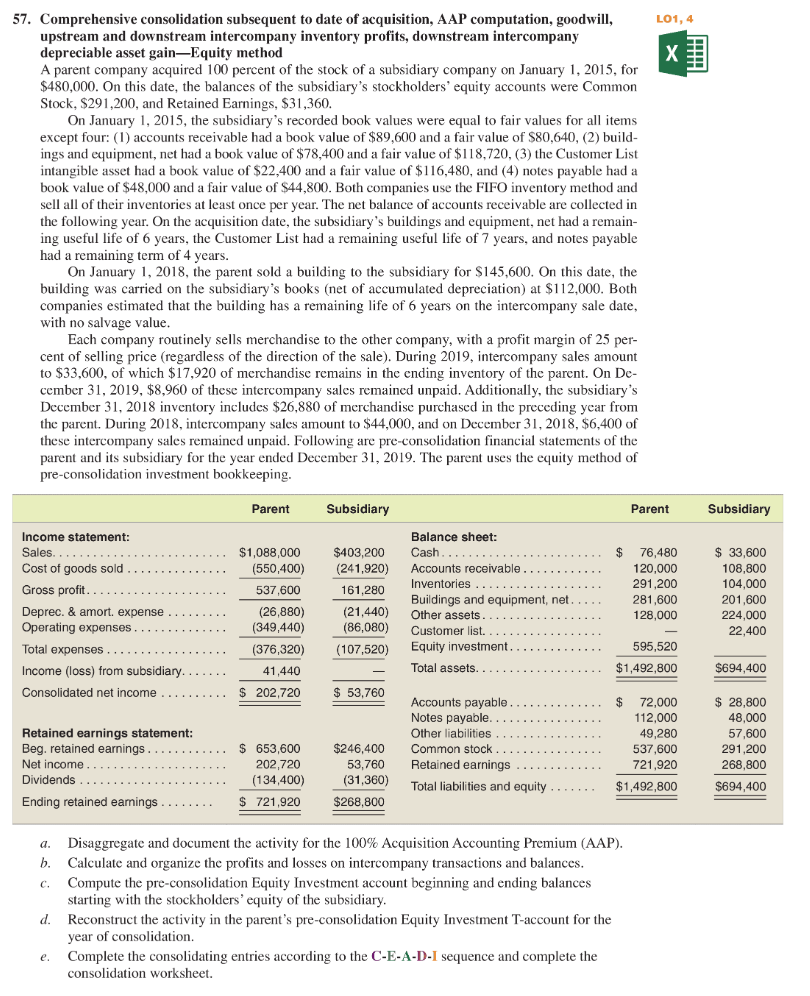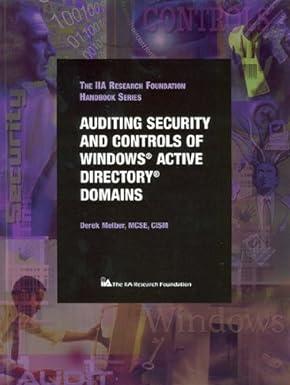
LO1,4 57. Comprehensive consolidation subsequent to date of acquisition, AAP computation, goodwill, upstream and downstream intercompany inventory profits, downstream intercompany depreciable asset gain-Equity method A parent company acquired 100 percent of the stock of a subsidiary company on January 1, 2015, for $480,000. On this date, the balances of the subsidiary's stockholders' equity accounts were Common Stock, $291,200, and Retained Earnings, $31,360. On January 1, 2015, the subsidiary's recorded book values were equal to fair values for all items except four: (1) accounts receivable had a book value of $89,600 and a fair value of $80,640, (2) build- ings and equipment, net had a book value of $78,400 and a fair value of $118,720, (3) the Customer List intangible asset had a book value of $22,400 and a fair value of $116,480, and (4) notes payable had a book value of $48.000 and a fair value of $44,800. Both companies use the FIFO inventory method and sell all of their inventories at least once per year. The net balance of accounts receivable are collected in the following year. On the acquisition date, the subsidiary's buildings and equipment, net had a remain- ing useful life of 6 years, the Customer List had a remaining useful life of 7 years, and notes payable had a remaining term of 4 years. On January 1, 2018, the parent sold a building to the subsidiary for $145,600. On this date, the building was carried on the subsidiary's books (net of accumulated depreciation) at $112,000. Both companies estimated that the building has a remaining life of 6 years on the intercompany sale date, with no salvage value. Each company routinely sells merchandise to the other company, with a profit margin of 25 per- cent of selling price (regardless of the direction of the sale). During 2019, intercompany sales amount to $33,600, of which $17,920 of merchandise remains in the ending inventory of the parent. On De- cember 31, 2019, $8,960 of these intercompany sales remained unpaid. Additionally, the subsidiary's December 31, 2018 inventory includes $26,880 of merchandise purchased in the preceding year from the parent. During 2018, intercompany sales amount to $44,000, and on December 31, 2018, $6,400 of these intercompany sales remained unpaid. Following are pre-consolidation financial statements of the parent and its subsidiary for the year ended December 31, 2019. The parent uses the equity method of pre-consolidation investment bookkeeping. Parent Subsidiary Parent Subsidiary $ Income statement: Sales.......... Cost of goods sold ............... Gross profit. ......... Deprec. & amort. expense ..... Operating expenses... Total expenses ............ Income (loss) from subsidiary....... Consolidated net income .......... $1,088,000 (550,400) 537,600 (26,880) (349,440) (376,320) 41,440 $ 202,720 $403,200 (241,920) 161,280 (21,440) (86,080) (107,520) Balance sheet: Cash........................ Accounts receivable............. Inventories ................... Buildings and equipment, net..... Other assets ........ Customer list. ............. Equity investment........ Total assets. ........... 76,480 120,000 291,200 281,600 128,000 $ 33,600 108,800 104,000 201,600 224,000 22,400 595,520 $1,492,800 $694,400 $ 53,760 Retained earnings statement: Beg. retained earnings ............ Net income..................... ...... Dividends ......... Ending retained earnings ........ $ 653,600 202,720 (134,400) $ 721,920 $246,400 53,760 (31,360) $268,800 Accounts payable .............. Noles payable................. Other liabilities ................ Common stock ................ Retained earnings ............. Total liabilities and equity ....... Total liabilities and $ 72,000 112,000 49,280 537,600 721,920 $1,492,800 $ 28,800 48,000 57,600 291,200 268,800 $694,400 a. Disaggregate and document the activity for the 100% Acquisition Accounting Premium (AAP). b. Calculate and organize the profits and losses on intercompany transactions and balances. Compute the pre-consolidation Equity Investment account beginning and ending balances starting with the stockholders' equity of the subsidiary. d. Reconstruct the activity in the parent's pre-consolidation Equity Investment T-account for the year of consolidation. Complete the consolidating entries according to the C-E-A-D-I sequence and complete the consolidation worksheet. LO1,4 57. Comprehensive consolidation subsequent to date of acquisition, AAP computation, goodwill, upstream and downstream intercompany inventory profits, downstream intercompany depreciable asset gain-Equity method A parent company acquired 100 percent of the stock of a subsidiary company on January 1, 2015, for $480,000. On this date, the balances of the subsidiary's stockholders' equity accounts were Common Stock, $291,200, and Retained Earnings, $31,360. On January 1, 2015, the subsidiary's recorded book values were equal to fair values for all items except four: (1) accounts receivable had a book value of $89,600 and a fair value of $80,640, (2) build- ings and equipment, net had a book value of $78,400 and a fair value of $118,720, (3) the Customer List intangible asset had a book value of $22,400 and a fair value of $116,480, and (4) notes payable had a book value of $48.000 and a fair value of $44,800. Both companies use the FIFO inventory method and sell all of their inventories at least once per year. The net balance of accounts receivable are collected in the following year. On the acquisition date, the subsidiary's buildings and equipment, net had a remain- ing useful life of 6 years, the Customer List had a remaining useful life of 7 years, and notes payable had a remaining term of 4 years. On January 1, 2018, the parent sold a building to the subsidiary for $145,600. On this date, the building was carried on the subsidiary's books (net of accumulated depreciation) at $112,000. Both companies estimated that the building has a remaining life of 6 years on the intercompany sale date, with no salvage value. Each company routinely sells merchandise to the other company, with a profit margin of 25 per- cent of selling price (regardless of the direction of the sale). During 2019, intercompany sales amount to $33,600, of which $17,920 of merchandise remains in the ending inventory of the parent. On De- cember 31, 2019, $8,960 of these intercompany sales remained unpaid. Additionally, the subsidiary's December 31, 2018 inventory includes $26,880 of merchandise purchased in the preceding year from the parent. During 2018, intercompany sales amount to $44,000, and on December 31, 2018, $6,400 of these intercompany sales remained unpaid. Following are pre-consolidation financial statements of the parent and its subsidiary for the year ended December 31, 2019. The parent uses the equity method of pre-consolidation investment bookkeeping. Parent Subsidiary Parent Subsidiary $ Income statement: Sales.......... Cost of goods sold ............... Gross profit. ......... Deprec. & amort. expense ..... Operating expenses... Total expenses ............ Income (loss) from subsidiary....... Consolidated net income .......... $1,088,000 (550,400) 537,600 (26,880) (349,440) (376,320) 41,440 $ 202,720 $403,200 (241,920) 161,280 (21,440) (86,080) (107,520) Balance sheet: Cash........................ Accounts receivable............. Inventories ................... Buildings and equipment, net..... Other assets ........ Customer list. ............. Equity investment........ Total assets. ........... 76,480 120,000 291,200 281,600 128,000 $ 33,600 108,800 104,000 201,600 224,000 22,400 595,520 $1,492,800 $694,400 $ 53,760 Retained earnings statement: Beg. retained earnings ............ Net income..................... ...... Dividends ......... Ending retained earnings ........ $ 653,600 202,720 (134,400) $ 721,920 $246,400 53,760 (31,360) $268,800 Accounts payable .............. Noles payable................. Other liabilities ................ Common stock ................ Retained earnings ............. Total liabilities and equity ....... Total liabilities and $ 72,000 112,000 49,280 537,600 721,920 $1,492,800 $ 28,800 48,000 57,600 291,200 268,800 $694,400 a. Disaggregate and document the activity for the 100% Acquisition Accounting Premium (AAP). b. Calculate and organize the profits and losses on intercompany transactions and balances. Compute the pre-consolidation Equity Investment account beginning and ending balances starting with the stockholders' equity of the subsidiary. d. Reconstruct the activity in the parent's pre-consolidation Equity Investment T-account for the year of consolidation. Complete the consolidating entries according to the C-E-A-D-I sequence and complete the consolidation worksheet







